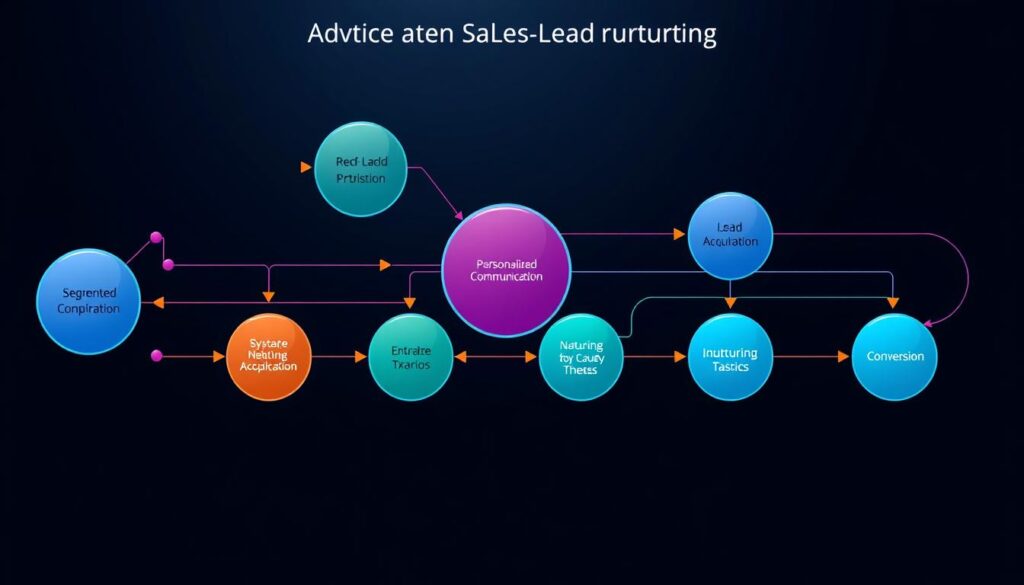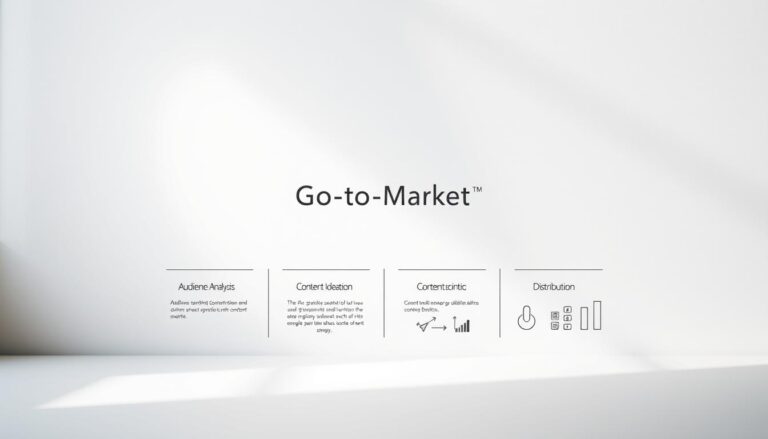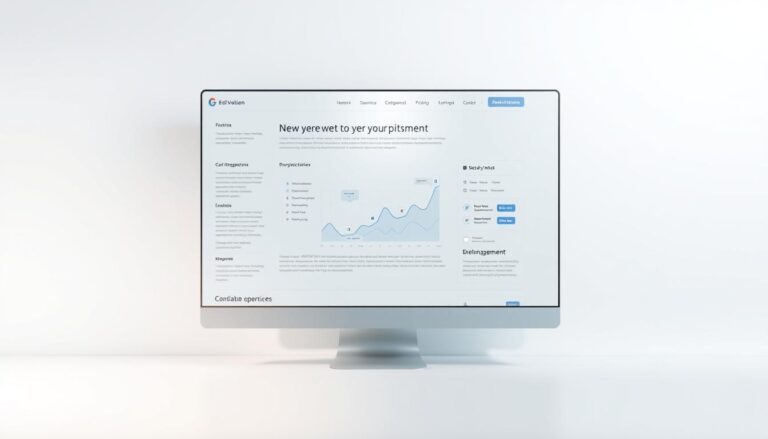In the competitive world of sales, businesses are searching for ways to be more efficient. Automated sales lead nurturing has become a key player. Sadly, about 80% of new leads don’t turn into sales. This highlights the need for effective nurturing. This guide will show you how automation tools have changed the game. They help turn potential customers into loyal ones.
Industry-leading nurture campaigns generate 50 percent more sales-ready leads at a 33 percent lower cost. This fact alone makes automation essential. An automated system gives every lead a personal experience. It ensures your brand’s message reaches potential customers at the right time.
To truly understand automated sales lead nurturing, you must know its ability to reach across multiple channels. These channels include email, social media, and more. With automation, you can improve lead management and qualification. This leads to better conversion rates.
Key Takeaways
- Automated lead nurturing helps close the gap between getting leads and making sales.
- Marketing automation tools enhance sales efficiency and create personalized experiences for customers.
- It’s important to keep in touch with leads regularly to build trust and guide them through the sales process.
- Using data for automation provides insights on which leads to focus on for better conversion chances.
- Combining CRM tools and AI helps manage leads better and close sales faster.
Understanding Automated Sales Lead Nurturing
Automated sales lead nurturing is a key part of a marketer’s toolkit. It helps guide prospects through the sales funnel. They do this by targeting the prospects’ needs and actions. Technologies like CRM automation play a big part. They nurture leads with little need for people, making marketing both consistent and personalized.
What is Lead Nurturing?
Lead nurturing is when businesses interact with potential customers to turn them into loyal ones. It’s central to CRM automation. Through automated emails and targeted actions, companies talk to their leads. It’s not just about selling. It’s more about building a strong relationship with ongoing, relevant talks.
Importance of Automation in Lead Nurturing
In today’s digital world, CRM automation is critical. With automated emails, businesses can connect with prospects personally yet efficiently. Tools like Salesforce’s Pardot help. They let marketers send out timely messages based on what the customer does. This makes the messages more relevant and timely.
| Feature | Description | Impact |
|---|---|---|
| Automatic Email Campaigns | Triggered by user behavior such as website visits, email opens, or form submissions. | Increases engagement by delivering timely and relevant content to leads. |
| Lead Scoring | Automated scoring of leads based on engagement and behavior. | Helps prioritize leads, allowing teams to focus on those with higher conversion potential. |
| Behavioral Tracking | Monitors lead interactions across various channels to tailor future communications. | Enhances personalization, fostering deeper connections and advancing leads through the funnel. |
| Drip Campaigns | Emails are sent out at regular intervals or in response to specific actions by leads. | Saves time and maintains engagement with minimal ongoing input. |
Using these tools makes marketing both simpler and more effective. This systematic approach boosts the move from prospect to customer. It’s powered by strong CRM systems and targeted emails. This is how lead nurturing strategies, aided by CRM automation and automated email campaigns, make a difference.
Key Benefits of Automated Sales Lead Nurturing
The use of automation in sales greatly improves an organization’s efficiency and productivity. By using automated lead qualification and lead scoring software, companies can better their operations. This leads to big cost savings and more leads ready for sales.
Increased Efficiency and Productivity
Automation helps simplify complex sales tasks. Businesses that use lead scoring software see a 14.5% rise in sales productivity and a 12.2% cut in marketing costs. These tools automate key tasks, letting sales teams focus on closing deals.
Enhanced Customer Engagement
Automated lead qualification ensures timely interactions with prospects. Through automated campaigns and advanced segmentation, there’s 50% more clicks on personalized emails. This targeting matches what modern customers expect, greatly raising engagement.
Improved Lead Conversion Rates
Automated tools greatly improve conversion rates. Data shows nurtured leads buy 47% more and have a 23% shorter sales cycle. Also, excellent lead nurturing results in 50% more sales-ready leads at a 33% lower cost, showing automation’s cost-effectiveness.

| Statistic | Data Point |
|---|---|
| Increase in sales-ready leads | 50% more |
| Reduction in nurturing costs | 33% lower |
| Increase in purchase size | 47% larger |
| Decrease in sales cycle | 23% shorter |
| Boost in engagement with nurtured leads | 50% higher than industry average |
This data clearly shows the big benefits of using automated lead qualification and lead scoring software. These tools significantly boost efficiency, engagement, and conversion rates. So, automation is key in today’s sales strategies.
Selecting the Right Tools for Automation
Starting a digital transformation? You need the best tools to help your sales and marketing teams. Marketing automation tools and CRM are key for better lead nurturing. These tools do more than just repeat tasks. They help create valuable conversations with potential customers.
Popular Automated Lead Nurturing Platforms
Many platforms offer great features for businesses. HubSpot Marketing Hub is loved for its complete services in marketing, sales, and customer service. It uses automated workflows to nurture leads well. Intercom is great for talking to customers on-site, making automated lead engagement easier. Unbounce helps create high-converting landing pages with over 100 templates. And OptinMonster lets you customize messages for users based on their location or device, enhancing CRM automation.
Factors to Consider When Choosing Tools
Choosing the right automation tools and CRM software is important. Here’s what to look for:
- Integration Capabilities: Make sure the tool works well with your current systems.
- Scalability: It should be able to handle your business’s growth without issues.
- User-friendliness: Pick something easy for your team to learn and use.
- Analytics Features: The tool should offer good analytics to improve your lead nurturing.
Also, consider how these tools affect sales and revenue. Statistics show a 14.5% increase in sales productivity and a 10% increase in revenue in 6-9 months with automation. Companies good at lead nurturing see 50% more sales-ready leads at 33% lower cost.

In the end, choose a platform that does more than task automation. It should give strategic insights and build relationships with your audience. This boosts your marketing strategy’s overall success.
Best Practices for Effective Lead Nurturing
To make the most out of automated sales lead nurturing, companies should follow certain best practices. These focus on making things personal and being efficient. We’ll dive into what these practices are and how they can make lead generation automation work best.
Segmenting Your Leads for Personalization
Understanding different customer groups is the first step in effective lead nurturing strategies. If you know what each group needs, you can tailor your approach. Personalizing your efforts can boost your conversion rates significantly. Stats show that personalized content can increase conversions by 2.5 times compared to non-personalized methods.
Crafting Targeted Content and Messaging
Making content that each group can relate to is key. It helps connect with prospects at every step of their buying journey. Companies that do this well see 50% more leads ready to buy. And they spend 33% less to get them there. This is because their content hits the mark, speaking directly to leads’ concerns and needs.
Monitoring and Analyzing Performance
Watching how your lead nurturing efforts do is crucial. Using automated tools helps gather data to tweak strategies as needed. Data shows that automated campaign emails bring in 18 times more revenue than standard ones. Plus, leads that have been nurtured tend to spend 47% more. This shows that keeping an eye on your nurturing program pays off.
| Metrics | Non-Nurtured Leads | Nurtured Leads |
|---|---|---|
| Average Purchase Size | Lower | 47% Higher |
| ROI | Lower | 45% Higher |
| Conversion Rate | Standard | 2.5 Times Higher |
| Cost Efficiency | Higher Costs | 33% Lower Cost |
The table shows clear benefits of nurturing leads versus not doing so. It emphasizes why automated sales lead nurturing is crucial. By adopting these techniques, businesses see big gains in sales effectiveness and efficiency.
Challenges and Solutions in Lead Nurturing
In today’s fast-changing digital market, businesses face the tough job of upgrading their lead nurturing. This is to meet the high expectations of modern consumers. Timely and personalized approaches greatly impact a customer’s choice, urging firms to perfect their lead nurturing strategies. They encounter hurdles like scaling personalization, generating diverse content, and keeping leads engaged without off-putting timing. This part looks into these issues and how companies can triumph over them.
Common Pitfalls to Avoid
Doing lead nurturing right is essential for marketing, but several mistakes can harm its effectiveness. Automated email campaigns that use CRM to segment leads show much promise. They have six times the transaction rates than non-targeted methods. Yet, 71% of markets face a tough time creating content that matches every buyer stage, emphasizing the need for precise lead segmentation. Without it, leads might just sit in the sales funnel, going nowhere.
Strategies for Overcoming Obstacles
To get past personalization and content relevance issues, marketers must embrace marketing automation tools. Such tools help create automated but personalized paths that move beyond a one-size-fits-all strategy. With smart use of data and lead scoring, marketers can focus their messages better. AI can also pitch in with content recommendations, deepening customer engagement. Key to success is also keeping a close eye on key metrics like click-throughs and conversions to continually improve efforts.
Future Trends in Lead Nurturing Automation
The future of lead nurturing is shaping up to be more intelligent and integrated. It will allow for even finer personalization. Considering 96% of visitors aren’t ready to buy on their first visit, the need for advanced personalization is clear. Predictive analytics offers a promising way forward, helping marketers foresee and adapt to future customer needs and behaviors. Thus, personalized messaging, powered by sturdy marketing automation and tight sales-marketing collaboration, is crucial. It paves the way for turning leads into real sales more smoothly.
FAQ
What is Automated Sales Lead Nurturing?
It’s a method that uses software to send personalized content to leads at different sales stages. Its goal is to educate and engage prospects. This helps turn them into paying customers.
How Important is Automation in Lead Nurturing?
Automation is key in lead nurturing. It keeps in touch with leads and sends them content at the right time. This way, it helps move leads through the sales funnel without losing the personal touch needed for customer relationships.
Why Should Businesses Increase Efficiency and Productivity in Lead Nurturing?
Increasing efficiency and productivity helps businesses manage more leads with less effort. It reduces mistakes and frees up teams for strategic work.
What Makes Enhanced Customer Engagement Essential in Lead Nurturing?
Engaging customers is crucial because it delivers content that meets their unique needs and interests. This builds trust and makes them more likely to buy.
How Do Improved Lead Conversion Rates Benefit a Business?
Better lead conversion rates make marketing and sales more effective. More leads turn into customers, boosting the company’s revenue and growth.
What Are Some Popular Automated Lead Nurturing Platforms?
Popular platforms include HubSpot, Marketo, Pardot, and Salesforce Marketing Cloud. They offer tools for automating lead nurturing.
What Should You Consider When Choosing Automation Tools for Lead Nurturing?
Look at how well tools work with your current systems, how they can grow with your business, ease of use, and their data analysis features.
Why is Segmenting Your Leads for Personalization Important?
Segmenting lets you customize communication for different audience groups. This leads to better engagement and more chances to convert leads.
How Does Crafting Targeted Content and Messaging Impact Lead Nurturing?
Targeted content ensures messages are relevant and helpful to the receiver. It addresses their needs and helps move them through the buying process.
What Role Does Monitoring and Analyzing Performance Play in Lead Nurturing?
Monitoring performance shows what’s working and what’s not. It guides decisions and improves campaign results.
What are Common Pitfalls to Avoid in Lead Nurturing?
Avoid not personalizing messages, ignoring lead scoring, sending too many messages, and not matching content to the buyer’s journey stages.
What Strategies Can Help Overcome Obstacles in Lead Nurturing?
Use personalized workflows, lead scoring software, and analyze engagement data. Avoid one-size-fits-all content to tackle lead nurturing challenges.
What are the Future Trends in Lead Nurturing Automation?
Future trends include using AI for better personalization, predictive analytics for accurate lead scoring, and combining marketing tools for a unified customer view.



